Research on the ecology and conservation biology of wood-inhabiting fungi has lately been active in northern Europe. Majority of the research has been focusing on a single species group, polypores, whereas the distribution, ecology and causes for threat for other wood-inhabiting fungi are still poorly known. For example, in the 2010 Red List of Finnish Species hundreds of wood-inhabiting Ascomycota species could not be evaluated. This consortium of three research projects aims to increase knowledge on deficiently known wood-inhabiting fungi, especially their ecology, distribution and causes for endangerment.
The consortium will span from 2012 to 2014, but some of the projects have started already earlier. The research group is led by Panu Halme from the University of Jyväskylä. Other members include Katja Juutilainen, Jenna Purhonen, Janne Kotiaho, Mikko Mönkkönen and Noora Vartija from the University of Jyväskylä, Seppo Huhtinen from the University of Turku and Heikki Kotiranta from the Finnish Environment Institute.

Mycena tintinnabulum, which is classified as vulnerable to extinction in Finland, is one of the species studied in the project. © Panu Halme
Environmental requirements of wood-inhabiting Ascomycetes, corticioids, agarics and dacryoid fungi in unmanaged forests
In this project we will study habitat requirements of these poorly known species groups. We will study the communities of these species groups in unmanaged and previously managed forests. With an especially accurate and detailed survey method we collect data from over 20 forests which differ in their stage of naturalness. We repeat the surveys several times per forest, and record occurrences of all the fungal species that have structures visible to the naked eye. We expect to get new information especially on species with small-sized fruit bodies.
The ecology and habitat requirements of corticioid fungi inhabiting small-sized decaying wood
In this project we will study corticioids that live on small-sized decaying wood. All dead wood larger than a needle will be collected from the studied coniferous, deciduous and grazed forests. Corticioids which occur on small-sized dead wood in several different forest habitats are probably not threatened even if there are only a few observations of them. However, species that are restricted to a single habitat might be threatened if the habitat type is rare or diminishing. This project will enhance the accuracy of the Red List evaluation for the species occupying small-sized dead wood particles.
Kuusimäki – an ecological laboratory of the endangered wood-decaying fungi
In this project we aim to build an ecological test laboratory out of Kuusimäki forest in Central Finland. The forest will be thoroughly studied so that it can be used as a reference site to similar environments elsewhere. Continuous research has taken place in Kuusimäki for over six years already, and in the current project we will continue collecting fungal data as well as measuring environmental variables. With the increasing knowledge of the species pool, local population sizes, community turnover, species detectability and other factors of the species occurring in Kuusimäki we can improve our estimates also in other forests with only scattered information. The ultimate aim is to be able to estimate the biodiversity qualities of other forests under protection, their stage of naturalness, species richness and the local population sizes of fungal species with conservation importance.
Common aims of all three research projects
Towards the end of the funding period we will be able to draw conclusions from the whole consortium project. For example, some species will be detected in all three research projects enabling us to combine information from several studies and predict population sizes of the species much more accurately than before. At the same time we can be much more certain that a species is endangered if we, in spite of the extensive effort put in the data collection, get only a few specimens or if we do not observe the species at all. To conclude, we expect that the results will help in enhancing the accuracy of the Red List evaluations and in targeting conservation and management efforts.
Further information
Panu Halme, University of Jyväskylä, tel. +358 40 805 4945, firstname.lastname(at)jyu.fi